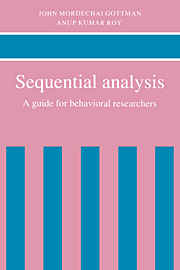Chapter 2 - History
from Part I - Introduction
Published online by Cambridge University Press: 10 November 2009
Summary
This chapter covers the history of sequential analysis, limited primarily to those applications that have bearing on the observation of social behavior in psychology. Readers should not worry too much about undefined terms. We will begin defining terms in Chapter 3.
Initially, interest in the mathematics of sequential analysis had to do with a concern about how to characterize change. In a seminal paper in 1952, George Miller introduced Markov processes into psychology by noting that probabilistic methods had proved themselves in sensory psychology and test construction, both of which rely heavily on the independence of observations and on invariance over time. He wrote,
The basic parameters can be explored at length because sequential effects of measurement are secondary and can be ignored or randomized. (p. 149)
However, for areas of psychology, such as learning, that are essentially concerned with change
…it is intrinsic in the very notion of learning that successive measurements are not independent; attempts to use a theory of independent variables must either fail or misrepresent the basic process. Such failures may lead to a rejection of statistical concepts as inadequate; a more proper attitude is to abandon the assumption of independence and ask what help can be had from dependent probabilities. (p. 149)
It is important to note that Miller was writing in the postwar context of the work of Norbert Wiener and his student Claude Shannon, and that the work of both was concerned with change and dependent data.
- Type
- Chapter
- Information
- Sequential AnalysisA Guide for Behavorial Researchers, pp. 9 - 14Publisher: Cambridge University PressPrint publication year: 1990



